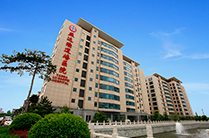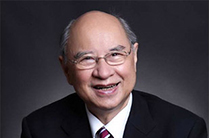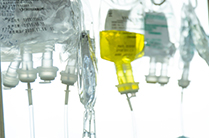Overview
Hodgkin's Lymphoma
Hodgkin's lymphoma, also known as Hodgkin's disease, is a type of cancer in the lymphatic system. A rare disease, Hodgkin's lymphoma causes some cells in the lymphatic system to abnormally reproduce, eventually causing tumors to grow and making the body less able to fight infection.
Hodgkin's lymphoma is different from other lymphomas. In most lymphomas, cancer cells make up most of a tumor. In Hodgkin's lymphoma, the cancer cells (usually special cells called Reed-Sternberg cells) only make up a small part of the cells in a cancerous lymph node. The rest of the cells are normal immune cells.
Prognosis
Hodgkin's lymphoma can usually be cured if found and treated early.
Symptoms
Hodgkin's Lymphoma Symptoms
These and other symptoms may be caused by Hodgkin's lymphoma. Other conditions may cause the same symptoms. A doctor should be consulted if any of the following problems do not go away:
• Painless, swollen lymph nodes in the neck, underarm, or groin
• Fever for no known reason
• Drenching night sweats
• Weight loss for no known reason
• Itchy skin
• Feeling very tired
• Coughing, shortness of breath or chest discomfort may be signs of Hodgkin's lymphoma in the chest.
Additional symptoms used in staging
Hodgkin's lymphoma stages are also noted by the presence or absence of certain symptoms of the disease:
• The letter "B" is added (i.e. stage IIB) if the person has any B symptoms (fever, night sweats, weight loss).
• If a person does not have these B symptoms, the letter "A" is added after the Roman numeral.
• If the Hodgkin's disease has spread from a lymph node to a nearby organ, the letter "E" is added.
• If it involves the spleen, the letter "S" may be added.
• The letter "X" may be added if a person has bulky disease. This means a tumor in the chest is at least one-third as wide as the chest, or a tumor in another area is at least 10 centimeters (about 4 inches) across. Bulky disease may require more intensive treatment.
For example, stage IIIB is disease that is symptomatic, involves lymph node regions or structures on both sides of the body and is further classified depending on the organs and areas involved.
Risk Factors
Risk Factors for Hodgkin's Lymphoma
Having a risk factor does not mean that you will get Hodgkin's lymphoma; not having risk factors doesn't mean that you will not get Hodgkin's lymphoma. Some risk factors are out of your control, such as age or gender. Known risk factors for Hodgkin's lymphoma include the following:
• Age: Occurs most often in people between ages 15 and 40, and in people over the age of 55.
• Family history: Off-spring, brothers and sisters of those with Hodgkin's lymphoma have a higher-than-
average chance of developing this disease.
• Sex: Slightly more common in men than in women
• Infection with the Epstein-Barr virus (EBV): Infection with the Epstein-Barr virus, which causes mononucleosis (also called "mono") has been linked to Hodgkin's disease.
• Infection with the human immunodeficiency virus (HIV): Infection with this virus, which causes AIDS, has also been linked to an increase risk of Hodgkin's disease.
• Weakened immune system: Inherited condition or the use of immunosuppressant drugs to prevent organ transplant rejection
Types
Types of Hodgkin's Lymphoma
Hodgkin's lymphoma is actually a group of similar diseases that doctors often classify into two main types:
• Classic Hodgkin's lymphoma
• Nodular lymphocyte-predominant Hodgkin's lymphoma
Classic Hodgkin's lymphoma
Most Hodgkin's lymphomas are the classical type that is broken down into four subtypes:
• Nodular sclerosing Hodgkin's lymphoma (most common)
• Mixed cellularity Hodgkin's lymphoma
• Lymphocyte depletion Hodgkin's lymphoma
• Lymphocyte-rich classical Hodgkin's lymphoma
Nodular lymphocyte predominant Hodgkin's lymphoma
Nodular lymphocyte predominant Hodgkin's lymphoma is a rare type. It is marked by the presence of a type of cell called a popcorn cell, which is different from the typical Reed-Sternberg cell found in classical Hodgkin's lymphoma. This type of Hodgkin's lymphoma may change into diffuse large B-cell lymphoma.
Diagnosis
Hodgkin's Lymphoma Diagnosis
Tests that examine the lymph nodes are used to detect (find) and diagnose Hodgkin's lymphoma. The following tests and procedures may be used:
A complete blood count (CBC) measures the size, number, and maturity of the different blood cells in a specific volume of blood. This is one of the most common tests performed.
• Red blood cells are important for carrying oxygen and fighting anemia and fatigue. The hemoglobin portion of the CBC measures the oxygen carrying capacity of the red blood cells while the hematocrit measures the percentage of red blood cells in the blood.
• White blood cells fight infection. Increased numbers of white blood cells, therefore, may indicate the presence of an infection. Decreased levels may indicate certain rheumatic diseases or reaction to medication.
• Platelets prevent the body from bleeding and bruising easily. It is usually performed to check for a blood infection.
A lymph node biopsy is the removal of all or part of a lymph node. A pathologist views the tissue under a microscope to look for cancer cells. During an excisional biopsy, an entire lymph node will be taken out whereas only a part of a lymph node will be removed during an incisional biopsy.
Other biopsies that may be done include:
• Excisional biopsy: entire lymph node is removed
• Incisional biopsy: part of a lymph node is removed
• Core biopsy: part of a lymph node is removed with a wide needle
A blood chemistry study is a procedure in which a blood sample is checked to measure the amounts of certain substances released into the blood by organs and tissues in the body. An unusual (higher or lower than normal) amount of a substance can be a sign of disease in the organ or tissue that makes it.
Physical exam and history is an exam of the body to check general signs of health, including checking for signs of disease, such as lumps or anything else that seems unusual. A history of the patient's health habits and past illnesses and treatments will also be taken.
Please provide your medical records to us before your appointment. At the visit itself, the nurses and doctors will ask additional questions and carry out a detailed physical exam.
A sample of blood is checked for the rate at which the red blood cells settle to the bottom of the test tube.
Treatments
Hodgkin's Lymphoma Treatment
We offer a full spectrum of the most up to date and advanced therapies for all stages of Hodgkin's lymphoma, including treatment for relapsed disease. Our treatment depends on the stage of disease and consists of chemotherapy alone, a combination of chemotherapy and radiation therapy (combined modality therapy), or raditaion therapy alone. Our focus is on using regimens that achieve a high cure rate, preserve fertility, and minimize late effects.
Types of treatment for Hodgkin's lymphoma include:
Chemotherapy is the basis of treatment for Hodgkin's lymphoma for most patients and uses drugs to stop the growth of cancer cells, either by killing the cells or by stopping them from dividing. When chemotherapy is taken by mouth or injected into a vein or muscle, the drugs enter the bloodstream and can reach cancer cells throughout the body. The standard approach to Hodgkin's lymphoma chemotherapy is treatment with more than one anticancer drug.
Drug combinations are used because different medications damage or kill cancer cells in different ways, making them more vulnerable to the treatment. Drugs added together in lower doses also help reduce the likelihood of side effects without reducing the overall amount of effective chemotherapy.
Radiation therapy is often used in the management of Hodgkin's disease, usually in combination with chemotherapy. Generally the sequence is to complete the chemotherapy and to follow up with radiation beginning 2-4 weeks later. Radiation is limited to the areas where disease was present at the time of diagnosis. The dose used is much lower than that required for common cancers such as prostate cancer or breast cancer. Small doses are given each day, 5 days per week, for 2 ½-5 weeks. Mild local side effects may develop in the area being treated, but they generally resolve shortly after treatment is completed.
When a patient's Hodgkin's lymphoma does not respond to primary treatment or returns, a stem cell transplant is recommended.
Bone Marrow Transplantation is the way to supply and replace extremely reduced and damaged hematopoietic stem cell. For more information about bone marrow transplantation please click here.
Patients with B cell Hodgkin's lymphoma may choose CAR-T Clinical Trial. This is a Phase I/II study designed to evaluate the safety and efficacy of chimeric antigen receptor T cell immunotherapy (CAR-T) in the treatment of CD19+, CD22+ and BCMA+ B cell lymphoma. For more information about CAR-T Clinical Trial, please click here.
(The content above extract from stanfordhealthcare.org)
-
-
Diseases ·
-














 京公网安备13108202000843号
京公网安备13108202000843号